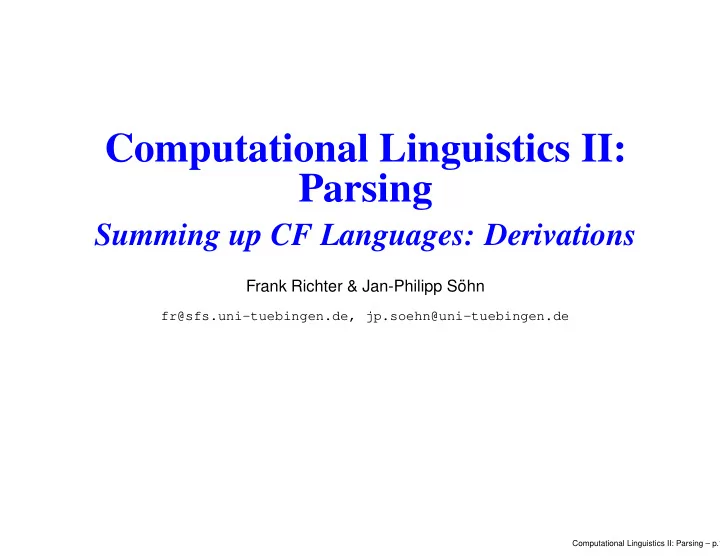

Computational Linguistics II: Parsing Summing up CF Languages: Derivations Frank Richter & Jan-Philipp S¨ ohn fr@sfs.uni-tuebingen.de, jp.soehn@uni-tuebingen.de Computational Linguistics II: Parsing – p.1
The Big Picture hierarchy grammar machine other type 3 reg. grammar D/NFA reg. expressions det. cf. LR(k) grammar DPDA type 2 CFG PDA type 1 CSG LBA type 0 unrestricted Turing grammar machine Computational Linguistics II: Parsing – p.2
Form of Grammars of Type 0–3 For i ∈ { 0 , 1 , 2 , 3 } , a grammar � N, T, P, S � of Type i , with N the set of non-terminal symbols, T the set of terminal symbols ( N and T disjoint, Σ = N ∪ T ), P the set of productions, and S the start symbol ( S ∈ N ), obeys the following restrictions: T3: Every production in P is of the form A → aB or A → ǫ , with B, A ∈ N , a ∈ T . T2: Every production in P is of the form A → x , with A ∈ N and x ∈ Σ ∗ . T1: Every production in P is of the form x 1 Ax 2 → x 1 yx 2 , with x 1 , x 2 ∈ Σ ∗ , y ∈ Σ + , A ∈ N and the possible exception of C → ǫ in case C does not occur on the righthand side of a rule in P . T0: No restrictions. Computational Linguistics II: Parsing – p.3
Derivation Steps of Grammars Definition For every grammar G with G = � N, T, P, S � and Σ = N ∪ T , for every u, v ∈ Σ ∗ , if there is a rule l → r ∈ P with u = w 1 lw 2 and v = w 1 rw 2 , where w 1 , w 2 ∈ Σ ∗ then u ⇒ 1 G v . We say that u directly derives v in grammar G . G for the reflexive transitive closure of ⇒ 1 We write ⇒ ∗ G and omit the subscript G if the grammar is clear from the context. Computational Linguistics II: Parsing – p.4
Language Generated by a Grammar Definition For every grammar G with G = � N, T, P, S � the language L ( G ) generated by G is G x } . L ( G ) = { x ∈ T ∗ | S ⇒ ∗ Computational Linguistics II: Parsing – p.5
More on Derivations (1) If at each step in a derivation a production is applied to the leftmost nonterminal, then the derivation is said to be leftmost . Computational Linguistics II: Parsing – p.6
More on Derivations (1) If at each step in a derivation a production is applied to the leftmost nonterminal, then the derivation is said to be leftmost . A derivation in which the rightmost nonterminal is replaced at each step is said to be rightmost . Computational Linguistics II: Parsing – p.6
Recommend
More recommend